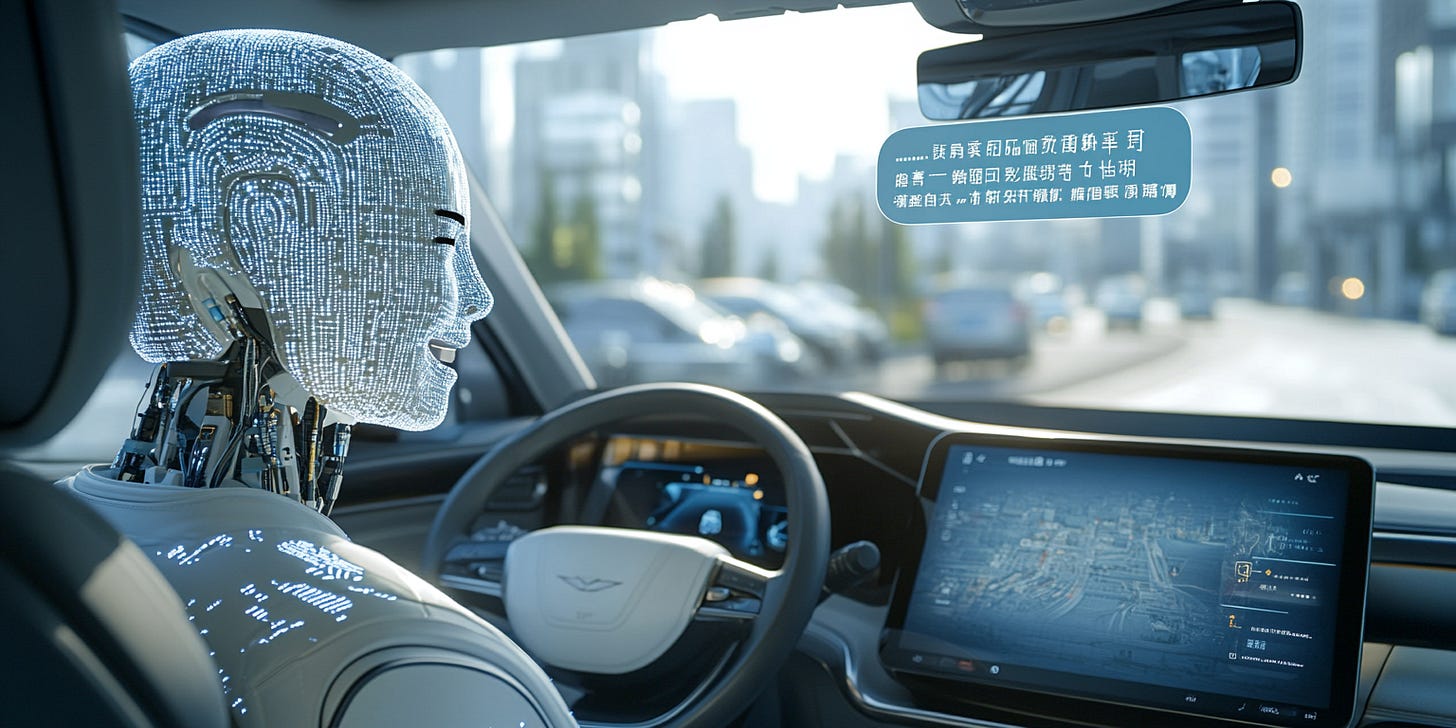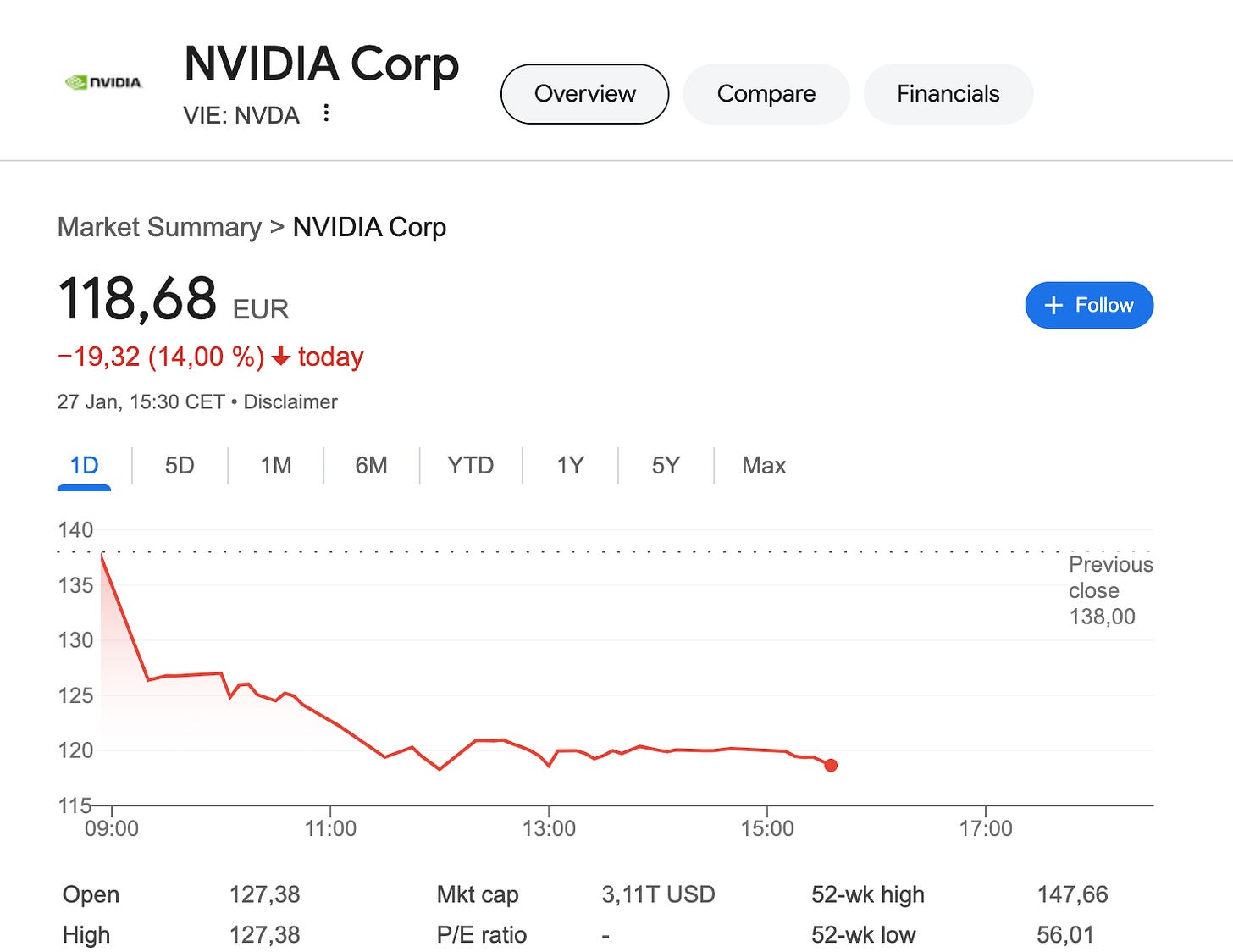A Tiny Chinese Startup Just Crashed Nvidia’s Stock
Trump's tariff threat can't distract from the fact that China is leaving US American tech in the dust. DeepSeek just showed Silicon Valley that it’s glory days are over
Are you wondering why Trump is pushing so hard for tariffs against China? Well, the billionaire bubble whispering in his ears is scared.
Sure, on the one hand, Trump doesn’t understand that tariffs hurt US consumers just as much as the countries he’s trying to cow into submission. On the other hand, big US corporations are heavily influencing his strategies.
Tech moguls aren’t just cozying up to him because they want more “masculine energy” in their companies. That’s just a distraction for the masses. They’re trying to use him to protect their business from Chinese competition. Competition that would flood Western markets with goods far superior to anything they can offer.
For a long time, we’ve been told that China produces only cheap, low-quality products. But that is a misdirection. Yes, the West mainly imports low-quality mass-produced products to satisfy local overconsumption trends as cheaply as possible. However, China has long developed into a technological giant with products that rival, if not surpass, Western competitors.
Case in point: NVIDIA stock just crashed 19%. Why? DeepSeek, the new AI kid on the block
.A tiny Chinese AI start-up just released an open-source AI model (R1). DeepSeek that rivals anything Silicon Valley has been able to develop so far.
According to Venture Beat, the company founded by hedge fund manager Liang Wenfeng created this model at 3% of OpenAI’s development cost.
Unlike the AI models we’re familiar with, DeepSeek uses reinforcement learning. The technical paper is available on GitHub for those who want to explore this technology further.
But Silicon Valley is not just startled by the cost. The release also disrupts all its assumptions about what’s required to achieve cutting-edge AI performance. It requires far fewer resources and still outperforms GPT4-o, Llama3.1, Claude-3.5, etc., in many ways.
To train its models, High-Flyer Quant secured over 10,000 Nvidia GPUs before U.S. export restrictions, and reportedly expanded to 50,000 GPUs through alternative supply routes, despite trade barriers. This pales compared to leading AI labs like OpenAI, Google, and Anthropic, which operate with more than 500,000 GPUs each.
This is the reason why NVIDIA stock is tanking.
The AI models created by Google and OpenAI, etc., need vast amounts of high-performing GPUs. NVIDIA is the company that has been delivering those GPUS. This sudden insatiable need has raised their stock price to unprecedented heights.
DeepSeek just demonstrated to the world that there’s a way to do AI while using only a fraction of Nvidia’s GPUs.
This is bad news for NVIDIA but good news for the environment. Using only 10% of the GPUs that OpenAI or Google’s models require means that this model will also use 90% less water and energy.
If you weren’t aware, AI models currently need an insane amount of resources. Google and Facebook are currently building their own nuclear reactors to power their models. Seems like this might be obsolete now as companies turn to this free, more resource-friendly option to implement their AI strategies.
At the time I was writing this, the R1 model had been downloaded 149K times from Hugging Face.
Of course, I tested DeepSeek over the weekend. What can I say? It’s really good. I might even cancel my ChatGPT subscription soon.
Did I mention, it’s free to use?
The release of DeepSeek has thrown Silicon Valley into a frenzy. It feels like the release was a Black Swan Event for the Tech Bubble. Accustomed to feeling superior to any other global technology hub, Silicon Valley was confident that no one could outpace them on the AI development front.
But it happened. They didn’t see it coming, and now all their business plans are tanking.
The Chinese electric vehicle market is light years ahead
AI isn’t the only technology the West is behind on. Last year, the EU and the US slapped Chinese electric cars (EVs) with tariffs. Their official reasoning: unfair competition. The Chinese government supposedly subsidizes the production of these cars to take over the European and US electric car markets.
They failed to mention another big reason: Chinese EVs are light years better than Western EVs. Given the lower prices of Chinese competitors, Western EV producers don’t stand a chance to hold their market shares. Tesla’s the US poster child of EVs is, at best, crappy and riddled with quality issues.
Europeans have slept on the trend—partly because of the political uncertainty surrounding the topic—so now European car manufacturers are struggling to survive in this new world. So much so that even Volkswagen, Germany’s flagship car producer, now has to fire 35,000 people—unthinkable just a decade ago.
I was aware that China had developed some very interesting EV alternatives. BYD has been heavily marketing its vehicles in the Austrian market in the past year. If I were to buy a new car, it would likely be an EV from them.
But signing up for RedNote a couple of weeks ago opened my eyes to the extent of the difference between Western and Chinese electric cars. Thank you, TikTok ban.
On RedNote or Xiaohongshu, which is the Chinese name of the app, I saw numerous videos of Chinese electric vehicles. Many of them are directly addressed to “American Friends.” Obviously, I’m not the only person intrigued by the Chinese EV market.
What I saw is that the affordability, features and functionalities of Chinese EVs are way beyond what is offered by Western EVs.
If you thought Trump and Co are trying to protect the free market, you’d be wrong; I’m convinced they want to close off the market so they can sell their mediocre products. Without competition. Especially if the competition looks like this.
I’ve downloaded some of the videos from RedNote so you can see some of the cars for yourself.
And, of course, this one. It’s probably not for daily use, but it does look vaguely familiar.
Unfortunately, RedNote videos can’t yet be directly embedded here on Substack because I’d love to show you more EVs.
In this light, Musk’s support of Trump and his anti-China agenda makes way more sense, doesn’t it?
These are just two examples, but if you dive deeper into modern tech alternatives produced in China, you’ll go down a rabbit hole. There are tons of gadgets that are either not available in the West or only produced for the luxury segment.
To name a familiar brand that has been impacted by bans and that had to overcome being locked out of the free market, there’s Huawei.
Their technology was used to run many of the big service provider networks. I experienced them as a tough competitor in many projects. They were always willing to invest unbelievable amounts of manpower into developing additional features the customer wanted. A service Western companies could not parallel.
So, they were banned in the US and the EU for possibly “spying” on Western networks. Did they spy? Who knows? The accusation sounds plausible and that’s all that matters.
It hasn’t stopped them from innovating.
Their phones and notebooks have long rivaled Western technology. Again, they were banned from using Google’s Play Store on those phones. What better way to make a product unattractive to Western consumers than blocking them from accessing their favorite apps?
If you can’t build a social media platform people want to use, kill the competition
If you think the TikTok ban is about protecting US American’s data (and children), you’d again be mistaken. It’s about Meta’s market share. TikTok’s algorithm and user experience are so superior to Meta’s Facebook and Instagram. They had no other way to get their profits back than to lobby relentlessly to get TikTok banned or into their grubby little fingers.
They paid A GOP firm to slander Bytedance. And, according to Sludge, they shattered the lobbying record by spending over $24 million to push this ban through.
Meta doesn’t care whether TikTok steals your data or not. They happily steal and sell your data all the time. We haven’t forgotten the Cambridge Analytica scandal, have we? They just don’t want the Chinese taking their market share and ad revenue by being better and more entertaining than them.
For some reason, US companies have decided that it is way easier to block competition than develop a superior product. Why do that when you can make more profit by not investing in innovative solutions?
A little Chinese AI startup just appeared from the left side and has blown Silicon Valley’s AI strategy focused on making the maximum profit out of the water.
I bet this is not the last time US tech oligarchs will be caught off guard in the coming years. Their strategy of exploitation and maximizing profit by blocking the competition won’t work forever.




I read an article on Google (?) praising the EV produced by the smart phone manufacturer Xiaomi. The writer was wondering why Xiaomi suddenly started a totally new product, and can do it so successfully - 150,000+ were sold in the first ten months, in China alone and with six months delivery waiting time. Western media didn't know or didn't want to report Xiaomi's motivation. I read the revelation of their CEO on Chinese media. He said he called a meeting with senior executives after learning that the US was going to impose sanctions on Xiaomi for alleged supporting the Chinese military. The meeting agreed that they have to diversify into new products - EV. The result is that they can design and build the SU7 in roughly 3 years. This shows how attempted suppression on a capable competitor will backfire.
I find it quite interesting that it’s the Chinese start-up which is “working smarter, not harder” while the US ones seem to be working more by brute force and buckets of money.
Aren’t our prejudices supposed to incline us towards thinking it’s more likely to be the other way around?